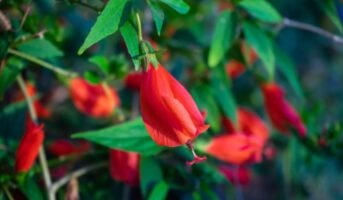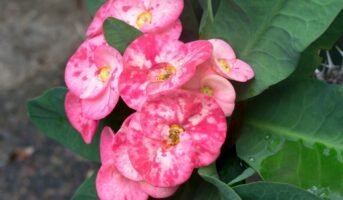Dolichandra unguis-cati, also known as funnel creeper, cat’s claw creeper or cat’s claw trumpet, is a woody vine that may climb up to 15 metres or higher and has a deep tuberous root system. It grows quickly and vigorously. It is a Bignoniaceae plant with bright yellow flowers. This plant is indigenous to the Caribbean, Central American, and South American tropical dry forests (from Mexico to Brazil and northern Argentina).
Tabebuia Rosea belongs to the Bignoniaceae family as well. Learn more about it.
Dolichandra unguis-cati: Key facts
| Biological Name | Dolichandra unguis-cati |
| Family | Bignoniaceae |
| Common names | Cat’s claw creeper, funnel creeper, cat’s claw trumpet |
| Native Distribution | Tropical America |
| Native Habitat | Terrestrial |
| Roots | The roots produce tubers |
| Foliage | Semipersistent |
| Flowers | Yes, yellow/golden, orange |
| Fruits | Yes |
| Habitat | Tropical |
| Cultivation | Propagated by seed |
| Soil | Dry soils/drought, moist soils, well-drained soils, fertile loamy soils |
| Light | Semi-shade, full sun |
| Water | Moderate water |
| Plant Growth Rate | Fast |
See also: Jade plants benefits and how to take care of them
Dolichandra unguis-cati: Physical description
Dolichandra unguis-cati is a clinging plant with woody stems that can grow up to 30 metres in height with semi-persistent foliage. It uses its adventitious roots and claw-like leaf tendrils to climb. The leaves of the plant are dark green, bifoliate and opposite. Leaflets measure 3 to 4 cm in length. Under the soil’s surface, lengthy primary roots grow, giving rise to huge tubers that measure 40–50 cm long.
The trumpet-shaped yellow flowers, which can grow singly or in clusters of two or three, measure 7 by 10 cm. From late spring through early summer, flowers are present. Their corolla is also tubular and ranges in length from 4 to 10 cm.

Source: Pinterest
Known about Orange trumpet vine
Dolichandra unguis-cati: How to grow
- Cat’s claw vines are simple to grow. Keeping it alive is typically not as difficult as keeping it under control. Cat’s claw plants can frequently emerge from the ground in unexpected places and spread via underground tubers. Planting it in a constrained area, such as between a wall and a piece of pavement, is the best approach to stop it from spreading.
- The sustainability of this vine’s growth will be greatly influenced by the time of planting. The best time to grow this plant is in the spring or early fall. Location is another crucial aspect of this plant’s growth, ensuring that there is enough space for growth where the roots and stems may spread freely.
- Cat’s claw plants are easy to propagate; they thrive from cuttings and can frequently be started from the seeds found inside their seed pods, which turn brown and split open in the fall.
- Gather the seeds and store them in a dry place until you’re ready to plant them. Do not cover them; simply press them into a pot where they can grow.
- Maintain soil moisture by wrapping the container in plastic wrap; seeds should germinate in three to six weeks, after which they may be moved to their final location in the garden.
Dolichandra unguis-cati: How to take care Cat’s claw plant care is easy.
- Although they’ll grow in just about any soil as long as it’s not waterlogged, vines tend to prefer moist, fertile, well-drained soil.
- They also need full to partial sun.
- Once they reach maturity, plants essentially take care of themselves with the exception of the occasional watering.
- Pruning the vine can also keep it smaller and more manageable.
Sunlight
This vine enjoys being out in the open in direct sunlight. It needs at least six straight hours of direct sunlight in order to bloom. Therefore, choose the location accordingly.
Water
It is advised to water the plant frequently when it is young, between two to three times a week, until it becomes settled. Once the plants are mature, frequent watering is not necessary, but it is still advised. Regularly assessing the condition of the soil and plants will help you decide how much moisture to apply.
Temperature and humidity
The plant is thought to be heat- and drought-tolerant because it enjoys the sun. The flowering of this plant is not favoured by cold seasons, and growth may become sluggish during certain times.
Fertiliser
Fertiliser should be applied only when necessary. Fertilisers high in phosphorus favour flowering, whereas those high in nitrogen will encourage more leaf growth. To prevent soil toxicity, always use the recommended amount of a product as directed on the label.
Soil
This plant grows quickly and is not particular about where it is placed, making it tolerant of different types of soil. The best soils are those that can drain well.
Trimming
The plant is maintained as often as necessary to keep dead sections from building up, reducing its susceptibility to disease. Additionally, the vine is trained to wreck the landscape and harm other existing vegetation.

Source: Pinterest
Dolichandra unguis-cati: Is it poisonous?
Consuming this plant orally for brief periods of time seems to be safe. However, it can also make some people feel dizzy and nauseous and can cause headaches.
This vine may irritate the skin when handled. The bark of this plant is fatal to parrots when ingested. It should be considered mildly toxic for animals and humans.
Dolichandra unguis-cati: Medicinal use
- In folk medicine, it has been used to treat snake bites. In addition to being an antipyretic, it is also used to treat dermatitis. It has also been used to treat oliguria, rheumatism, diarrhoea, malaria, and venereal illnesses due to its anti-inflammatory properties. The anti-tumoral and antitrypanosomal properties present in its leaves are also been reported.
- Today, cat’s claw is sold as a dietary supplement for a number of illnesses, including parasites, herpes, human papillomavirus, HIV, arthritis, diverticulitis, peptic ulcers, colitis, gastritis, haemorrhoids, leaky bowel syndrome, Alzheimer’s disease, and cancer.
- The bark and root have been used as traditional medicines in South America for ages for a variety of ailments, including inflammation, cancer, and infections.
- Supplements made from this plant can be consumed as a liquid extract, pill, powder, or tea.
FAQs
How fast does Dolichandra unguis-cati grow?
The majority of cat’s claws grow and reach their full size in two to three months.
How often should I water my cat's claws?
It is advised to water the plant frequently when it is young, but once the plants are mature, frequent watering is not necessary, but it is still advised.
Housing News Desk is the news desk of leading online real estate portal, Housing.com. Housing News Desk focuses on a variety of topics such as real estate laws, taxes, current news, property trends, home loans, rentals, décor, green homes, home improvement, etc. The main objective of the news desk, is to cover the real estate sector from the perspective of providing information that is useful to the end-user.
Facebook: https://www.facebook.com/housing.com/
Twitter: https://twitter.com/Housing
Email: [email protected]











